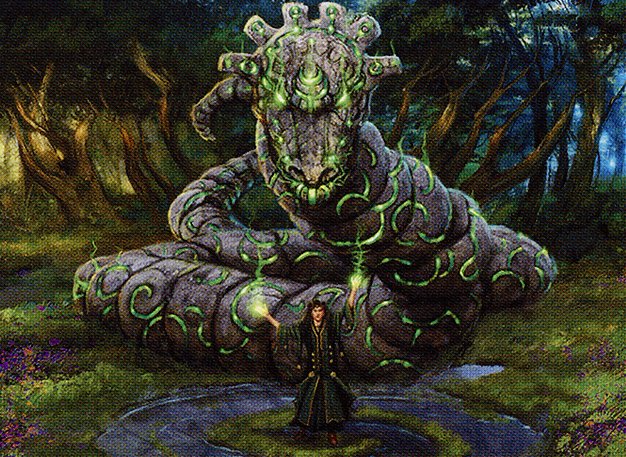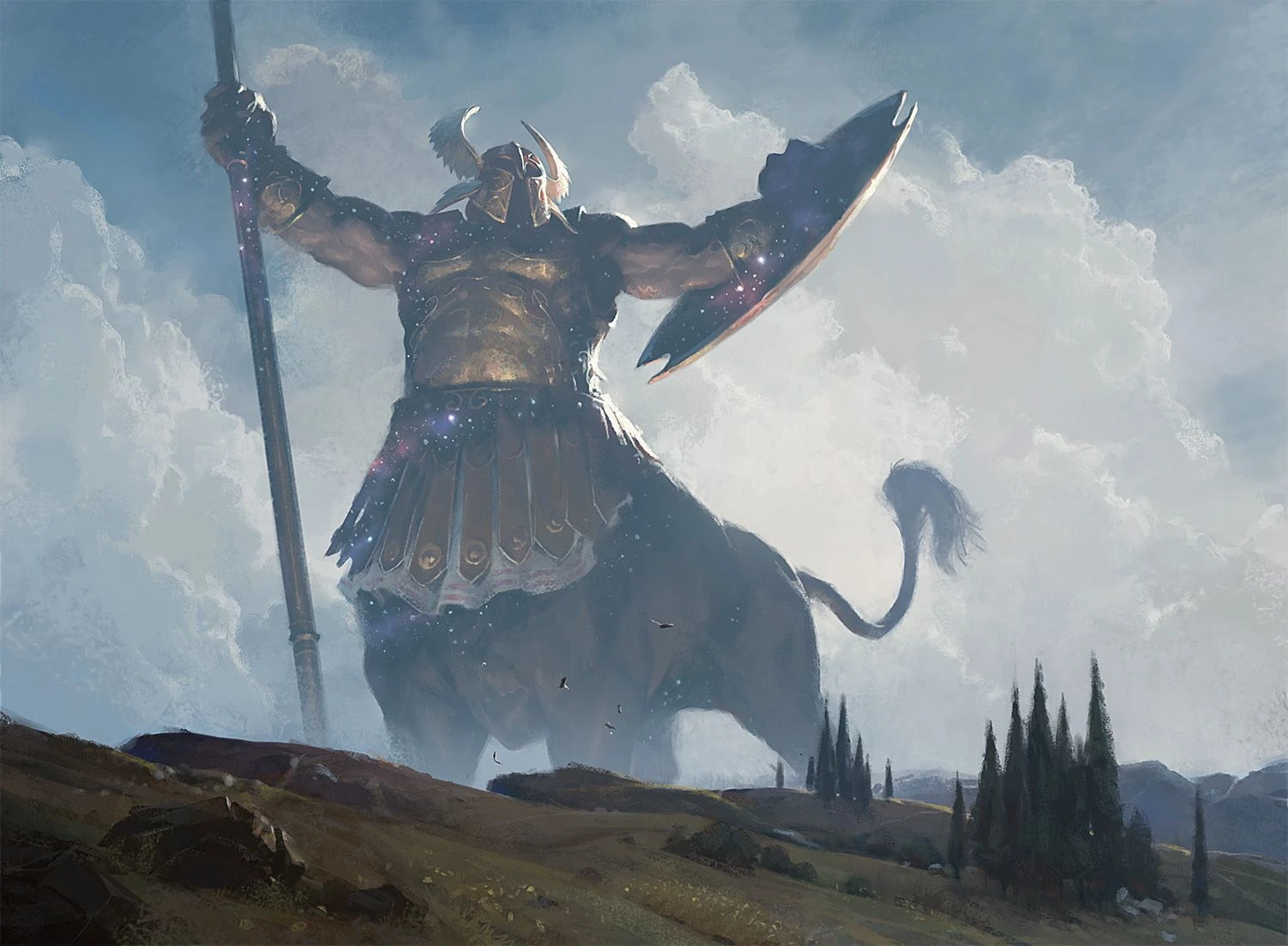Table of Contents
Welcome back to Brewin’ Shoes, the column where I try my best to convince you my crazy nonsense builds will work for more people than just myself. This week, I bring you a deck I’m quite confident will work for everyone, however, because I’ve played an absurd amount of games with this deck. I enjoyed playing it on the ladder so much that I even decided to make it my paper deck for my local gaming store’s Standard league this season (where I’m performing quite well so far).

So let’s start right off with the decklist this time around:
Decklist



Creatures (27)
Artifacts (2)
60 Cards
$71.08
Sideboard
15 Cards
$15.97
Now, if you really have your nose deep in Standard’s ground, you may not consider this deck to be too far out there, because I’m certainly not the first person to attempt a Steel Overseer Standard deck since its reprinting in M20. I do still feel that this qualifies as a brew, however, because I built this in my usual process of brewing, and because I found myself once again scrolling through every single Standard card on Gatherer and thought jamming some Steel Overseers could be fun with reasonable support. Me and the ol’ Overseer go way back as I’ve played a lot of Affinity in Modern through the years (R.I.P Mox Opal, gone but never forgotten).
So let’s break it down, as my boy Lucio from Overwatch would say:
The Bots



4 Stonecoil Serpent: It’s almost difficult to write about why this card is in the deck because of how obvious it feels to me at this point. Serpent scales well into the late game and is loaded with incredible keyword abilities in Trample, Reach, and Protection from Multicolored. All three of those abilities really matter these days, Trample makes this one of the best creatures to wear All That Glitters, Reach allows blocking of popular threats like Phoenix of Ash and Dream Trawler, which segues perfectly into Protection from Multicolored. A 1/1 Stonecoil Serpent can block Dream Trawler forever. It can’t be bounced by Teferi, killed by Bedevil, hit by Mayhem Devil, and that’s barely scratching the surface. The final nail in the man-this-card-is-sweet coffin is that playing this on turn one for X=1 allows us to follow our preferred play pattern of one drop into two drop payoff effectively as well. This saves us from mulligans where we don’t have a one drop, as long as we have a Serpent. Just remember it can’t wear Staggering Insight, truly the only downside the card has.
4 Gingerbrute: I wish Arena had facecams, because Arena is the only place where you miss out on the look on your opponent’s face when you go Island into Haste one drop, attack for one. It’s truly classic. Haste on this fits well with many aspects of the deck from allowing it to come down, get a counter from Overseer, and get in for two immediately, and the same with both enchantments, allowing it to come in swinging from the deck with Mystic Forge, and just being a one mana guy as well. The evasion he can get for just one mana per turn is also very good, making him another excellent target for All That Glitters, as well as Staggering Insight. Quite often Gingerbrute is what allows us to stumble across the finish line after the opponent tries to stabilize.
3 Inquisitive Puppet: At one point, there were four of these in the deck and three Locthwain Gargoyle but the numbers were switched, as I found the extra point of toughness to be quite relevant against Mono Red specifically. However, the scry on Puppet is quite nice and the ability to get a 1/1 when they attempt to remove it is sometimes relevant as well. I won’t be switching back anytime soon, but you could if you disagree with my analysis. That being said, Puppet is quite good as well, being another one mana guy for Steel Overseer to buff, scrying cards away for more Mystic Forge action, and blanking opposing 1/1s on turn one. Most importantly, the art on Inquisitive Puppet is adorable.
4 Locthwain Gargoyle: As explained above, I was initially not very high on this card. I figured it would be a 0/3 for one pretty much all of the time, which would be fine for Artifact count but not exciting. Boy, was I wrong. I have paid for mana happily many times to send this thing flying in and for two more damage. I have even had that extra two points of damage provide quite a few kills. Locthwain Gargoyle is even a fine target for the auras in the deck as well, albeit not as exciting as some of the other cards, as you’ll happily pay four mana per turn to give this flying if it’s wearing an All That Glitters. Also, it turns out that a 0/3 on turn one is really good against Mono Red quite often, as some of you may know from experience with our good friend Arboreal Grazer.
4 Corridor Monitor: The lack of good artifact creatures in Standard means that a 1/4 for two mana would probably be playable here by itself, but this deck can also abuse the Monitor’s ability through several means. Using it to untap your Steel Overseer, allowing for a second activation in one turn, is incredibly powerful and will nearly always prompt a “Nice” emote from your opponents.. It can also be used to untap Mystic Forge, allowing for a deeper dig and increasing the likelihood of a possible chain of cards in one turn. Overall, The ol’ Hall Monitor is an easy inclusion in the deck, and allows for some of the most fun sequences available.
4 Steel Overseer: Two mana 1/1, dies to Shock and Stomp every time, blah, blah, blah. On a more serious note, the lord of this deck does die a lot. Like a lot a lot. That’s just the nature of playing Steel Overseer in any format. You think he doesn’t die a lot in Modern? The secret to having success with this card is to try to read and bait removal, or even using Overseer himself to bait removal to ensure something like an All That Glitters or Mystic Forge will stick. If you manage to have an Overseer stick around for just a turn or two without being removed, it will easily take over the game.
4 Arcanist's Owl: Owl can find literally every card in the deck that is not a land; this is the ideal home for it.. It has a decent flying body, making it an excellent bearer of auras, and is a reasonable threat on its own. Having an Owl can make some hands with no immediate payoff (i.e. All That Glitters, Steel Overseer) keepable as it can find them for you later in the game. Overall, it ends up being one of the most important cards in the deck, despite its heavy mana cost. It’s also the reason I chose not to include any lands that produce colorless mana.
The Payoffs



2 Mystic Forge: I’ll get more into why I chose this instead of other options in the Honorable Mentions section later but, other options aside, Mystic Forge has been superb for me ever since I first tested it. It can play 28 of the cards in the deck (not counting the first Forge itself), giving you great odds of finding something each turn at least as you get to dig two cards deep, and lots of the cards in the deck allow you to see even deeper with Temple of Enlightenment, Inquisitive Puppet, and Corridor Monitor. The matchups where this really shines are the slower games, like Control or Jeskai Fires, but it’s a fine card in any game where you can afford to tap out to cast it. I think the best play for this card is to apply enough pressure to the board to force an opponent to tap out to wipe the board, allowing you to resolve this on your subsequent turn. It’s incredibly difficult for any deck to outgrind Mystic Forge, barring bad RNG. It fills the role of Experimental Frenzy in Mono Red without making us blank on the card we actually draw.
4 Staggering Insight: Although Staggering Insight isn’t truly a payoff for an Artifacts matter style deck, this effect is just too powerful to ignore and the deck was sorely in need of some card advantage. The Lifelink is also incredibly relevant in today’s Standard (I’m looking at you, Mono Red). Putting this on even a Locthwain Gargoyle creates quite a blocker. As stated above, this cannot be placed on Stonecoil Serpent. At first, I thought this could be a reason that Staggering Insight may not be in the final version of the deck, but that ended up not being the case at all. The deck is full of great targets to put this on, and the card draw is essential to counteracting the card disadvantage of playing a bunch of creatures that are ineffectual by themselves. If you can hit for an activation of this, you nearly always should; be wary of removal when looking to land this though – maybe don’t throw it on Gingerbrute if your Mono Red opponent has 2 mana up on turn 2!
4 All That Glitters: The final obvious payoff for the deck, the bonus from this will always be huge. It counts every single nonland card in the maindeck. We designed the deck this way for a reason and it’s all right here in All That Glitters. This will turn any creature into an absolute monster capable of tangling with big threats like Cavalier of Thorns and Dream Trawler. The best targets for this include Arcanist’s Owl and Stonecoil Serpent, but it will serve you just fine on any creature. Again, be wary of removal when looking to apply this to a creature, but the risk to reward ratio here is quite worth it in my opinion. Note that it’s often correct to wait to apply this until it can generate an immediate kill, allowing for fewer turns for an opponent to have sorcery speed removal or find an answer in general.
The Lands
As stated under Arcanist’s Owl, I found there to be no room for colorless lands in this deck, making for a simple manabase here (And much less wildcard intensive than last week!).
4 Hallowed Fountain: Makes blue, makes white, comes in untapped, what’s not to love? Not too much explanation needed here.
4 Temple of Enlightenment: This on the other hand, will sometimes make you want to pull your hair out. For every time it’s amazing with a Mystic Forge in play, there’s a draw where these absolutely neuter your ability to curve out ideally. That is why these are one hundred percent the only tapped land I would ever consider playing in this deck.
8 Plains, 7 Island: We really need untapped sources in this deck to apply maximum pressure. Basics both do that and cast our Arcanist’s Owls so they are needed. And cheap, so you’re welcome for that!
The Sideboard



3 Hushbringer: I am perfectly aware this is the sketchiest include in the sideboard and deck as a whole. In fact, in yesterday’s guide to deckbuilding, I specifically mentioned not to do exactly this (This being put Hushbringer in a deck with Enter the Battlefield effects). With that being said, I found myself nearly always losing to Cat Oven being assembled, so here we are. I like to just swap this in for the Corridor Monitors when I need it.
1 Dance of the Manse: I really wanted to sneak one of these into the maindeck, but it routinely sat dead in hand while we died to aggressive decks, so it landed here. Dance allows for an immediate reload after a sweeper, and that’s precisely what we want it for. Lose to a Shatter the Sky? Consider Dance of the Manse in game two. If you can’t see yourself wanting this too often it is also fine to remove this from the sideboard. The fun factor on this card is a solid nine or ten out of ten, so for me it stays.
1 Disdainful Stroke, 2 Dovin’s Veto, 2 Mystical Dispute: After tons of testing various counterspells and mixes, I ended on a light spread. I find myself wanting different counters in each matchup, but some of these work for multiple things (i.e. both Dovin’s Veto and Disdainful Stroke counter Fires of Invention and Wilderness Reclamation) and for that reason I have a few of each. I don’t want to bring in more than three counterspells very often, because we’re an aggro deck and need a critical mass of pressure to win.
2 Glass Casket: As further explained below, I really wanted this to make the maindeck, but alas. Glass Casket is still incredible against decks loaded with targets for it (And in the mirror if this deck ever takes off!) so I would never leave home with less than two. If I were to cut Dance of the Manse for something, I’d probably be adding a third Casket.
2 Revoke Existence: I’m always a big fan of Disenchant effects as long as there are good targets for them running around. Good targets for this now include Fires of Invention, Wilderness Reclamation, Nightmare Shepherd, Enigmatic Incarnation, Banishing Light, and quite a few more. I’m happy to have two, but more would be a bit overboard.
2 Sorcerous Spyglass: Playing as much Standard as I have in my life, I’ve played with this card quite a bit before. Despite that, I wasn’t really sold on it here until I watched someone cast Fry on a Dream Trawler at my local last week because they had a Spyglass naming Trawler in play. I afterwards asked if he really sideboarded that just to beat Trawler and he listed off all the good targets for it in UW Control (Teferi, Narset, Trawler, Castles). Ever since then, I was in; it’s an Artifact as well, for what it’s worth!
Honorable Mentions



Emry, Lurker of the Loch: So close. And that’s why she tops this section. Emry is a powerful card, no doubt, but she just never panned out for me in testing. She dies just as much as Steel Overseer does and can’t be found by things like Owl and Forge, while dropping the overall Artifact count for the deck. Either way, you could play her if you so wish, and she definitely has her moments. I’m playing her in Pioneer, for what it’s worth.
Glass Casket (Maindeck): This card performed really well in testing against the decks with many targets for it like Mono Red and Mono White. The issue I had with it was that I felt I was already strong enough in those matchups and could grant the slots towards hedging my worst matchups in Control. That’s why I slotted in Mystic Forge. Being able to find removal with your Arcanist’s Owls is really sweet though, so Casket is always something to keep in mind.
Manifold Key: It turns out Corridor Monitor is much better as a creature. Jokes aside, the synergy here is powerful but the differences are key (There’s your pun for today). Where Corridor Monitor is still fine without Overseer or Forge in play, this card is much less useful without them. Paying three to make something unblockable can be fine, but not usually exciting. In the end, I opted to ditch the Key.
Chamber Sentry: Only being able to cast this for X=2 really hurt this and ultimately led to it being cut from the deck. Again, the decks that this was strong against (Things full of X/1s to shoot down) didn’t feel like the places where we needed another card that was moderately successful. Chamber Sentry is a respectable card and can always just be cast as another one mana guy, but he didn’t quite do enough for me.
Dovin, Grand Arbiter: Dovin actually originally held the slots now held by my prized Mystic Forge. I am quite biased here because I really love Dovin, but I actually think he is quite good in the deck. There are multiple ways to make him fit if you desire, such as cutting the Inquisitive Puppets or replacing Mystic Forge. Neither of those are officially recommended by me, but if you’ve got some Dovins lying around you’ve always wanted to use, this is your chance.
Clockwork Servant: I just really wasn’t in the market for a three mana 2/3 even if it does cantrip most of the time. This deck plays aggressively, and our little clockwork friend really doesn’t fit into that theme for me. Maybe if you wanted to slow the deck down you could try this, but I really don’t see this deck being very effective in a more midrange fashion this Standard.
Castle Vantress / Castle Ardenvale: There just wasn’t room for any possibility of these coming in tapped for me. I did try Ardenvale at first, but with only 12 Plains total (And 11 Islands for Vantress) I did get punished a few times. The payoff of getting 1/1s of irrelevant typing for five mana just did not fit this style of deck. My Castles will continue to be used elsewhere.
Karn’s Bastion: This is probably the land that came the closest to making the cut. Proliferate just seems so sweet with Steel Overseer, but in practice this card is very “winmore”, meaning that most of the time you have a board full of creatures with counters on them and effectively five mana to spend to proliferate, you should already be winning. Bastion is awful against sweepers and doesn’t help in Control matchups as a result. The number of times that this helped win a game that was not already being won was definitely lower than the number of times where it hindered Arcanist Owl.
How to Play the Deck
We all know at this point that I have streamlined this deck to be aggressive. So get out your SMOrc emotes and send your creatures hard! There are of course opportunities to play around sweepers sometimes, as well as to avoid enchanting a creature that could be removed. For the most part however, we want to apply pressure; that’s the whole point of aggro after all. Being too scared to be aggressive will often lead you to lose with this deck even more so than other aggro decks because our creatures are so weak on their own.
I have developed the most basic mulligan strategy, made possible by London Mulligans. I will mulligan all the way to five aiming for any one drop with any two drop payoff (Steel Overseer, Staggering Insight, All That Glitters) nearly all of the time. Exceptions can be made such as three lands, three artifact creatures and an Arcanist’s Owl or Mystic Forge depending on the situation. Most of the time though, a hand of just artifact creatures not named Steel Overseer won’t get the job done so I tend to mull aggressively with this deck.
In the early game, look to start activating Staggering Insight or Steel Overseer to get ahead on resources and board, respectively. Against aggressive decks we usually just intend to race, pulling ahead with lifelink or by leaving a high toughness creature or two back to block. Against Control decks, we look to apply lethal pressure without emptying our hand fully, leaving us able to reload from a sweeper.
We aim to close the game out by applying a lethal All That Glitters or just having a large board from Steel Overseer. Mystic Forge and Arcanist’s Owl shine here by helping us find the killing blow. Small things like the activated abilities of Locthwain Gargoyle and Gingerbrute can help us stumble across the finish line as well. The kills the deck manages out of nowhere are really funny sometimes.
Matchups

Jeskai Fires
As a sometimes slow deck, we can occasionally just blast them with a fast start in game one, depending on if our board is weak to Deafening Clarion or Teferi. Be wary of those cards as you determine which threats you look to deploy. If their removal lines up well to your threats, it can be tough, but if they’re staring down a board of 0/3s with +1/+1 counters with a Deafening Clarion as their answer, we can pick up the win. Things like countermagic and Revoke Existence can come in from the sideboard as well to help with the matchup. Overall, I rate this match as pretty winnable, but not incredibly skewed either way.
Mono Red Aggro
The Shock-less version of this deck is a much better matchup as it makes our Steel Overseers more likely to survive, but overall this match can really be navigated well to be a good matchup. Things like not applying a enchantment to anything with two or less toughness while they have access to mana for removal will make this feel much more winnable. Getting lifelink active from Staggering Insight on something with good toughness can really win the game all on its own, or swing the race if that’s the strategy we’re employing. Knowing when to race and when to block can be tough, but it’s quite a bit easier for me when I just always assume they have an Embercleave in hand. Glass Casket and Revoke Existence are both quite good out of the sideboard here.
Simic Flash
This deck just takes some getting used to for any deck to play against. Simic Flash is loaded with counterspells and ways to punish you for slow rolling threats to avoid being countered. This is not one of my favorite matchups for the reason that we just have to jam threats and hope they don’t have it for the most part. Slow rolling is not a great option here, although forcing out counters to resolve a Mystic Forge is absolutely incredible here. I like Mystical Dispute and Dance of the Manse from the sideboard in this match, but Hushbringer could also be considered. The skill of both players can really be on display in these games.
Temur Reclamation
Can we kill them before being swept? Another matchup where that question is highly relevant, but one where they can struggle to kill a massive creature, so for that reason I find myself winning this match quite a lot. Reclamation can struggle to find its feet against a fast draw from us, and that’s just what this deck is looking to punish. Gotta go fast! Revoke Existence can be fine from the sideboard, but Dovin’s Veto and Disdainful Stroke are especially exciting.
Azorius/Esper Control
The sweepers and Teferis of this deck punish us quite a bit harder than the ones available to the other decks. This matchup is tough; no way around it. It’s not unwinnable however, and tight play can still bring it home. Definitely look to force a sweeper and have a strong follow-up play available like Mystic Forge or Owl. It’s also possible they keep a slow hand and we just crush them before they get set. The die roll is incredibly important here. Countermagic is good from the sideboard, although I have stopped bringing in Mystical Dispute here because it costs three to counter Shatter the Sky. Sorcerous Spyglass is excellent, and Dance of the Manse can be attempted here too.
Mono White Aggro/Devotion
This matchup is typically incredibly fun. Both players attempt to build a huge board, and whichever player’s plan comes together better generally takes the win. Our start can be a bit faster, so I do like my winrate here. Steel Overseer is often free to perform in this match as most of these decks are playing little to no removal in the maindeck. Speaking of removal, I like Glass Casket out of the board here, as well as Revoke Existence depending on how many targets it has. Classic Aggro v. Aggro fun to be had here.
Rakdos/Jund Sacrifice
As mentioned before, this deck can have real troubles with Mayhem Devil, depending on boardstates. The combination of that, Cat Oven combo, and their solid removal package all come together for a hard and rarely enjoyable matchup. Hushbringer can be good here, along with Dance of the Manse and Sorcerous Spyglass. Not a big fan of Glass Casket here because it can easily be blanked by a sacrifice outlet.
Mono Black Devotion
Do people still play this deck? In all seriousness I’m aware that some people do, and we don’t struggle quite as hard with Cat Oven here, if they are even opting to include it. They have some decent removal as well, but I think most people have found that Mono Black struggles to get it done in time. This is another deck that we can usually prey on for things like being too slow and hurting themselves with cards like Midnight Reaper and Murderous Rider. Hushbringer can be good if you see Cat Oven in game one, as can Sorcerous Spyglass. Mono Black is just loaded with sweet targets for Spyglass and they have no way to remove it.
Selesnya/Bant Bogles (Enchantments)
The other All That Glitters deck in the format, this match is another that’s a bit of a race. They can struggle to compete with Steel Overseer draws, and can’t force damage through with Alseid of Life’s Bounty due to our creatures being colorless, so that’s a bonus. I’ve personally come to believe that I am playing the better All That Glitters deck in this matchup, but their boards can get out of hand as well. Revoke Existence is obviously incredible here, and Glass Casket can be quite good.
Closing Thoughts
In the end, I was glad to play this instead of the Selesnya Enchantment deck. I like being able to go wide with Steel Overseer, and I like being able to win from nowhere with a sudden hit from All That Glitters. Overall, I’d say this is a pretty good aggro deck, as I climbed quite a bit with it this season, and am still having success with it in my local league. It’s incredibly fun, and provokes use of your noodle a bit more than some of the other aggro decks available.
Another great thing about this deck is the budget aspect of it. If you’re an Arena player thinking about trying paper magic, this deck is incredibly cheap, with most of the cost being in acquiring the lands. On Arena itself, it doesn’t cost too many wildcards (again, especially if you already have the lands).
So get out there, make some giant robots, and let me know what you think in the comments here, on the Discord, or on Twitter @CallMeDodgy.
Until next time,
Dodgy.

Premium
Enjoy our content? Wish to support our work? Join our Premium community, get access to exclusive content, remove all advertisements, and more!
- No ads: Browse the entire website ad-free, both display and video.
- Exclusive Content: Instant access to all exclusive articles only for Premium members, at your fingertips.
- Support: All your contributions get directly reinvested into the website to increase your viewing experience!
- Discord: Join our Discord server, claim your Premium role and gain access to exclusive channels where you can learn in real time!
- Special offer: For a limited time, use coupon code L95WR9JOWV to get 50% off the Annual plan!








































